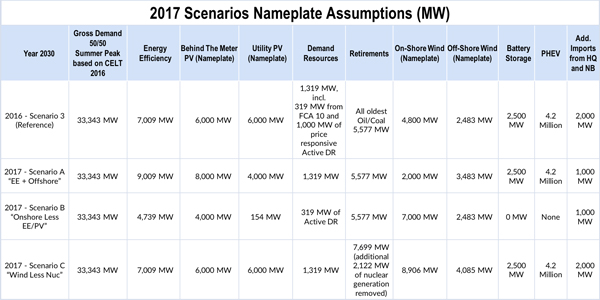By Rich Heidorn Jr.
ISO-NE could see substantial “spillage” of renewable energy and large price separations because of transmission constraints under scenarios considered in the RTO’s 2017 Economic Study, officials told the Planning Advisory Committee on Wednesday.
The study was requested by the Conservation Law Foundation to evaluate scenarios for meeting Massachusetts and Connecticut climate laws and the Regional Greenhouse Gas Initiative’s emission caps.
The study was based on the “Renewables Plus” scenario from the 2016 Economic Study, which modeled the year 2030 — the only scenario in the 2016 study to meet the RGGI cap. (See Study: New Resources Could ‘Crowd Out’ Old in ISO-NE.)
Under Renewables Plus, the generation fleet met existing renewable portfolio standards, and new renewable or clean energy resources were added above existing RPS requirements.
The new study looked at three additional scenarios:
- “EE + Offshore”: Added more energy efficiency and offshore wind while reducing imports from Canada by 1,000 MW.
- “Onshore Less EE/PV”: A variation on the business-as-usual base case from the 2016 report, with onshore wind boosted to 7,000 MW (nameplate capacity) from 4,800 MW in the reference case.
- “Wind Less Nuc”: Assumes the Millstone nuclear plant retires by 2030, five years ahead of its license expiration, with the gap filled by renewable/clean energy resources.
The study found all three scenarios met projected demand, even with transmission constraints based on the “as-planned” system’s internal and external transfer limits.
If transmission constraints are not relieved, the RTO would see “spillage” of wind power north of the Surowiec-South interface, leading to lower prices in Northern Maine than southern New England. For example, under the constrained scenarios, 7 to 18% of renewables would be spilled, with 22 to 89% of the spillage north of Surowiec-South.
In the constrained Wind Less Nuc scenario, average LMPs would range from $13.78/MWh in the Bangor Hydro Electric subarea in northeastern Maine, to $38.71/MWh in the NH subarea (which includes most of New Hampshire, eastern Vermont and southwestern Maine) and $37.18/MWh in Boston.
Electric production by natural gas plants fluctuates with assumptions regarding plant retirements and price-taking offers ($0/MWh) by renewable resources. EE + Offshore has the least gas-fired energy, while Wind Less Nuc has the most gas production, especially when the transmission system is constrained.
EE + Offshore had the lowest total production costs, coming in 28% below the Renewables Plus reference case assuming transmission constraints. Onshore Less EE/PV had the highest costs, 77% above the constrained reference case.
Only one scenario, EE + Offshore, is as good as the Renewables Plus scenario in meeting the RGGI 2030 emission targets.
CLF staff attorney David Ismay said the two emission-reduction targets, which were also used in the 2016 study, were intended to “bracket” the goals RGGI might embrace in its latest program review. RGGI’s emissions cap declines by 2.5% annually through 2020. The group announced in August that it would seek an additional 30% reduction in emissions from 2020 levels.
“We expressly worked … to design all three scenarios to meet [RGGI] emissions targets,” Ismay said.
“We’re starting to get a better picture of what the grid needs to look like in order to meet our climate laws and emission regulations that are already on the books,” he explained in an interview later. “We really need a grid that’s different from what we have now. I think that will give legislators, regulators and the ISO information on the kind of mix we need to comply with these laws. … It’s really helpful to see the impact of adding 1,000 MW of EE or 1,000 MW of wind.”
Stakeholders have until April 2 to submit requests for additional economic studies. Requests should be emailed to PACMatters@ISO-NE.com.




